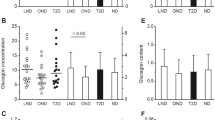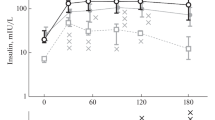Summary
In twelve obese children (relative weight 161–222%) threshold studies of insulin secretion were performed after administration of increasing doses of glucose I.V. (0.02, 0.04, 0.08 and 0.33 g/kg body weight) given at 0, 60, 120, and 180 minutes. Glucose and immunoreactive insulin (IRI) levels were determined at short intervals after each dose. The contrast group consisted of twelve subjects of normal body weight selected in such a way that the total weight of the two groups was comparable. The IRI, IRI/Glucose quotient and the increment of IRI over the baseline values (Δ IRI) were significantly increased in the obese group. The response to the smallest glucose dose allowed to divide the obese into two subgroups: group A with a normal Δ IRI and group B with a considerably increased Δ IRI.
Determination of the body composition by means of a whole body counter showed that patients of group B have more fat tissue than patients of group A. These results clearly indicate that the pathological insulin secretion is related to body composition.
Zusammenfassung
Bei 12 adipösen Kindern (relatives Gewicht 161–222%) wurden Schwellenuntersuchungen der Insulinsekretion durchgeführt. Glucose wurde in steigenden Dosen (0,02, 0,04, 0,08 und 0,33 g/kg) und stündlichen Abständen innert einer Minute intravenös verabreicht. Glucose und immunoreaktives Insulin (IRI) wurden in kurzen Intervallen nach jeder Dosis bestimmt. Als Kontrollgruppe dienten 12 Normalgewichtige, die so gewählt wurden, daß das totale Gewicht der beiden Vergleichsgruppen ähnlich war. Die Glucosetoleranz war in beiden Gruppen identisch. Das IRI, der IRI/Glucosequotient und der IRI-Anstieg (Δ IRI) waren bei den Adipösen bei allen Dosen signifikant höher. Die kleinste Glucosedosis erlaubte die Unterteilung der Adipösen in zwei Gruppen: Gruppe A mit normalem Δ IRI und Gruppe B mit stark erhöhtem Δ IRI. Die mittels Ganzkörperkaliumbestimmung geschätzte Körperzusammensetzung zeigte, daß die Adipösen der Gruppe B mehr Fettgewebe aufweisen als diejenigen der Gruppe A. Die Resultate zeigen, daß die pathologisch vermehrte Insulinsekretion mit der Körperzusammensetzung zusammenhängt.
Similar content being viewed by others
References
Kreisberg, R. A., Boshell, B. R., Di Placido, J., Roddam R. F.: Insulin secretion in obesity. New Engl. J. Med.276 314 (1967)
Bagdade, J. D., Bierman, E. L., Porte, D.: The significance of basal insulin levels in the evaluation of the insulin response to glucose in diabetic and nondiabetic subjects. J. clin. Invest.46, 1549 (1967)
Paulsen, E., Richenderfer, L., Ginsberg, F.: Plasma glucose, free fatty acids and immunoreactive insulin in sixty-six obese children. Diabetes17, 261 (1968)
Chiumello, G., Del Guercio, M. J., Carnelutti, M., Bidone, G.: Relationship between obesity, chemical diabetes and beta pancreatic function in children. Diabetes18, 238 (1969)
Weber, B.: Plasmainsulin bei Kindern, klinische Studien bei stoffwechselgesunden, adipösen und diabetischen Probanden. Arch. Kinderheilk. Beiheft 65. Heft (1971)
Schultz, R. B., Parra, A.: Relationship between body composition and insulin and growth hormone responses in obese adolescents. Diabetes19, 492 (1970)
Loridan, L., Sadeghi-Nejad, A., Senior, B.: Hypersecretion of insulin after administration of 1-leucine to obese children. J. Pediat.78, 53 (1971)
Karam, J. H., Grodsky, G. M., Pavlatos, F. Ch., Forsham, P. H.: Critical factors in excessive serum-insulin response to glucose. Lancet1965I, 286
Crockford, P. M., Salmon, P. A.: Hormones and obesity: Changes in insulin and growth hormone secretion following surgically induced weight loss. Canad. med. Ass. J.103, 147 (1970)
Rabinowitz, D., Zierler, K.: Forearm metabolism in obesity and its response to intraarterial insulin: characterisation of insulin resistance and evidence for adaptive hyperinsulinism. J. clin. Invest.41, 2173 (1962)
Salans, L. B., Knittle, J. L., Hirsch, J.: The role of adipose cell size and adipose tissue insulin sensitivity in the carbohydrate intolerance of human obesity. J. clin. Invest,47, 153 (1968)
Heimendinger, J.: Neue Standardmasse für Kinder. Helv. paediat. Acta13, 471 (1958)
Gruelich, W. W., Pyle, S. I.: Radiographic atlas of skeletal development of the hand and wrist, sec. ed. Stanford: University Press 1959
Nicholson, J. P., Zilva, J.: Body constituents and functions in relation to height and weight. Clin. Sci.27, 97 (1964)
Teuscher, A., Richterich, R.: Neue schweizerische Richtlinien zur Diagnose des Diabetes mellitus. Schweiz. med. Wschr.101, 345, 390 (1971)
Documenta Geigy: Wissenschaftliche Tabellen, Redaktion K. Diem und C. Lentner, 7. Aufl., S. 701. Basel: J. R. Geigy, A. G. Pharma. 1968
Richterich, R.: Klinische Chemie, 3rd ed. Basel-New York: S. Karger 1971
Hales, C. N., Randle, P. J.: Immunoassay of insulin with the insulin antibody precipitate. Biochem. J.88, 137 (1963)
Loeb, H.: Contribution à l'étude du métabolisme énergétique de l'enfant, p. 37. Bruxelles: Editions Arscia 1963
Donath, A., Poretti, G., Müller, O., Zuppinger, A.: The determination in children of total body potassium by 40K measurement with a liquid scintillation whole body counter. Its importance in clinical pediatric routine. Radioaktive Isotope in Klinik und Forschung IX. München-Berlin-Wien: Urgan & Schwarzenberg 1970
Donath, A.: Total body potassium, lean body mass and total fat determination in 7 to 16 years old children with a liquid scintillation whole body counter. Monographs in pediatrics. Basel-New York: S. Karger Publishers. (In preparation)
Forbes, G. B.: Lean body mass and fat in obese children. Pediatrics34, 308 (1964)
Karam, J. H., Ching, K. N., Burrill, K., Schmid, F. G., Grodsky, G. M.: Stepwise stimulation of insulin secretion: Evidence for multicompartmentalization and multiphasic insulin release in man. Diabetes20, Suppl.1, 323 (1971)
Felig, P., Marliss, E., Cahill, G. F.: Plasma amino acid levels and insulin secretion in obesity. New Engl. J. Med.281, 811 (1969)
Author information
Authors and Affiliations
Additional information
Supported by the Swiss National Science foundation Grant number 3.473.68.
Rights and permissions
About this article
Cite this article
Jacot, J.P., Zuppinger, K.A., Joss, E.E. et al. Evidence for two types of juvenile obesity on the basis of body composition and insulin release following small doses of glucose. Klin Wochenschr 51, 1109–1114 (1973). https://doi.org/10.1007/BF01468305
Issue Date:
DOI: https://doi.org/10.1007/BF01468305




